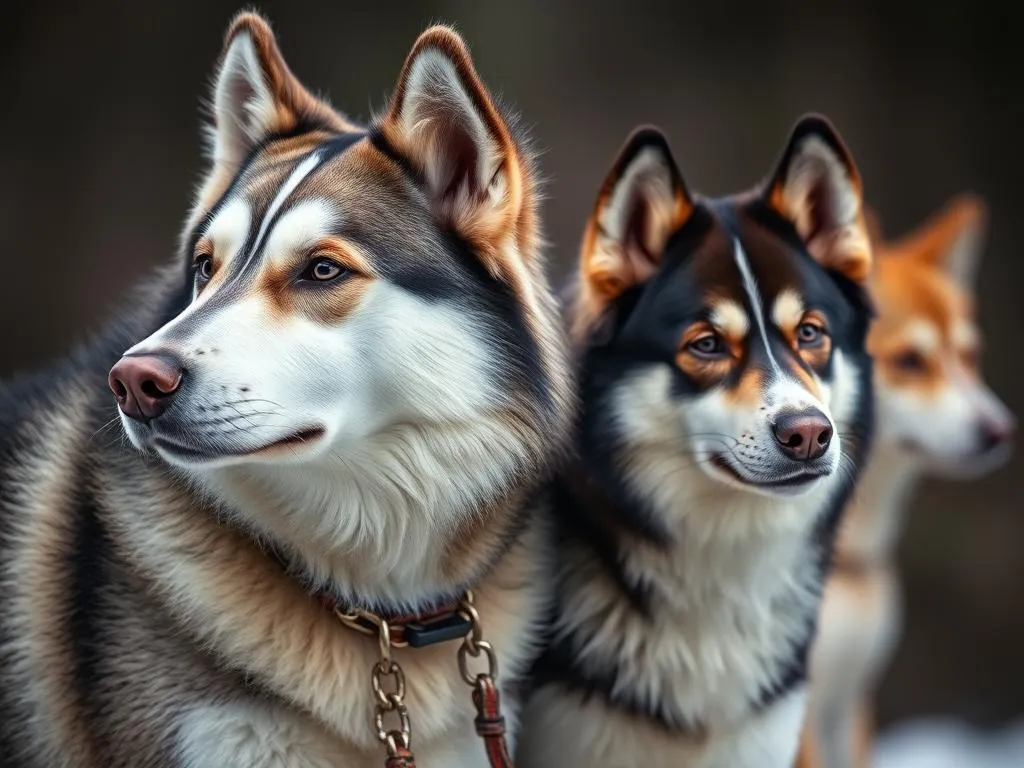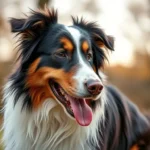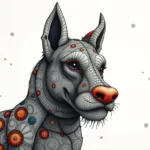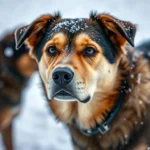
Introduction
Sled dog breeds have captured the hearts of many with their strength, endurance, and unique personalities. Defined primarily as dogs bred for pulling sleds over snow-covered terrains, these breeds have served various purposes, from transportation to companionship. Historically, sled dogs played a pivotal role in the survival of Indigenous cultures across the Arctic and Antarctic regions, where they were essential for hunting and transportation during harsh winters. Their significance extends beyond practicality; in many communities, sled dogs are celebrated for their loyalty and bond with humans.
As we delve into the fascinating world of sled dog breeds, it’s essential to understand their characteristics, traits, and suitability for various lifestyles. This article aims to educate readers about these remarkable dogs while shedding light on their history, care requirements, and modern roles.
Section 1: Understanding Sled Dogs
What are Sled Dogs?
Sled dogs are a unique category of working dogs bred for their ability to pull sleds across snowy landscapes. These breeds are characterized by their powerful build, thick fur coats, and high energy levels. Unlike other dog breeds, sled dogs possess a strong prey drive and a remarkable level of endurance, allowing them to traverse long distances in harsh conditions. Furthermore, they are known for their friendly dispositions and pack mentality, which makes them excellent companions for those who understand their needs.
History and Origin of Sled Dogs
The historical significance of sled dogs is deeply rooted in Indigenous cultures, particularly among the Inuit and other Arctic peoples. These dogs were not just pets; they were vital for survival, helping communities transport goods, hunt for food, and navigate challenging terrains. Over time, various breeds evolved, each adapted to specific environments and tasks. For instance, the Siberian Husky was bred by the Chukchi people for endurance, while the Alaskan Malamute was developed for heavier hauling tasks.
The Role of Sled Dogs Today
Today, sled dogs continue to play a significant role in our lives, both as working animals and beloved pets. They are widely recognized in the world of sports, with events like dog sledding, skijoring, and weight pulling showcasing their incredible abilities. Many enthusiasts participate in sled dog races, which not only test the dogs’ endurance but also foster a deep bond between the handler and their team. Beyond sports, these breeds are increasingly valued for their companionship and loyalty in homes around the world.
Section 2: Popular Sled Dog Breeds
Siberian Husky
Originating from Siberia, the Siberian Husky is one of the most popular sled dog breeds. Bred by the Chukchi people, these dogs were designed for endurance and speed over long distances.
- Physical Characteristics: Siberian Huskies are medium-sized, with a striking double coat that can come in various colors. Their distinctive blue or multi-colored eyes add to their captivating appearance.
- Temperament and Personality Traits: Known for their friendly and outgoing nature, Huskies are social dogs that thrive in a pack environment. However, they can be independent and stubborn, requiring consistent training.
- Care and Exercise Needs: Huskies need ample exercise and mental stimulation, ideally requiring at least 1-2 hours of activity daily. They are not suited for apartment living unless provided with sufficient outdoor time.
Alaskan Malamute
The Alaskan Malamute is another prominent sled dog breed, known for its strength and size.
- Physical Characteristics: These dogs are large, powerful, and have a thick double coat, primarily in shades of gray, black, and red.
- Temperament and Personality Traits: Malamutes are loyal and affectionate but can be aloof with strangers. They tend to be more reserved than Huskies and require a firm handler to guide them.
- Care and Exercise Needs: Alaskan Malamutes need regular exercise and enjoy activities like pulling sleds or carts. They thrive in cold climates and require plenty of space to roam.
Samoyed
The Samoyed is easily recognizable by its fluffy white coat and friendly smile.
- Origin and History: Originally bred by the Samoyede people of Siberia, these dogs were used for herding reindeer and pulling sleds.
- Physical Characteristics: Samoyeds are known for their thick, white coat, which helps them withstand freezing temperatures. They have a sturdy build and a characteristic “Sammy smile.”
- Temperament and Personality Traits: Samoyeds are friendly, gentle, and eager to please, making them excellent family pets. However, they require consistent training and socialization.
- Care and Exercise Needs: These dogs are energetic and need regular exercise, ideally in cooler weather. Their thick coat requires regular grooming to prevent matting.
Greenland Dog
The Greenland Dog is a lesser-known yet remarkable sled dog breed.
- Origin and History: Bred by the Inuit for hunting and pulling sleds, Greenland Dogs are one of the oldest sled dog breeds.
- Physical Characteristics: They are large, strong dogs with a thick double coat, often seen in various colors from black to gray.
- Temperament and Personality Traits: Greenland Dogs are known for their loyalty and protective nature. They can be reserved with strangers but are affectionate with their families.
- Care and Exercise Needs: Regular exercise is crucial, as these dogs thrive on physical activity. They require a strong handler and can be challenging for novice owners.
Chinook
The Chinook is a rare and versatile sled dog breed.
- Origin and History: Developed in the early 20th century in New Hampshire, Chinooks were bred for pulling sleds and working with livestock.
- Physical Characteristics: They are medium to large-sized dogs with a short to medium coat that can vary in color.
- Temperament and Personality Traits: Chinooks are friendly, intelligent, and eager to work, making them great family pets. They are known for their gentle demeanor and adaptability.
- Care and Exercise Needs: Chinooks require regular exercise and mental stimulation. They thrive on activities that challenge their intelligence, such as obedience training and agility courses.
Other Notable Sled Dog Breeds
In addition to the aforementioned breeds, several other notable sled dog breeds deserve mention:
- Canadian Eskimo Dog: Known for their versatility and strength, these dogs are excellent at pulling sleds and have a rich history among Indigenous peoples in Canada.
- Biewer Terrier: Although not a traditional sled dog, some smaller breeds have been used in lighter sledding tasks due to their agility and trainability.
Section 3: Choosing the Right Sled Dog
Factors to Consider
When considering a sled dog breed, it’s essential to evaluate several factors:
- Lifestyle and Living Situation: Sled dogs thrive in active environments. If you live in an apartment or have a sedentary lifestyle, you may want to reconsider.
- Activity Level and Exercise Requirements: These breeds require regular exercise and mental stimulation. Ensure you can meet their physical demands.
- Compatibility with Children and Other Pets: Most sled dogs are friendly, but individual temperaments vary. Early socialization is essential for harmonious living.
Training and Socialization
Training and socialization are crucial for sled dogs, which are often independent thinkers.
- Importance of Early Training: Start training as early as possible to establish a strong bond and set boundaries.
- Tips for Training Sled Dog Breeds: Use positive reinforcement methods and be consistent. Socializing your dog with various people and environments will help them develop into well-rounded companions.
Health Considerations
Regular check-ups and a balanced diet are vital for the health of sled dog breeds.
- Common Health Issues: Sled dogs can be prone to hip dysplasia, eye disorders, and certain genetic conditions. Regular veterinary care is essential.
- Importance of Regular Check-Ups: Keeping up with vaccinations and health screenings will help catch any issues early.
Section 4: Caring for Sled Dogs
Nutrition Requirements
Proper nutrition is essential for the health and performance of sled dog breeds.
- Dietary Needs Specific to Sled Dog Breeds: These dogs require a high-protein diet to support their energetic lifestyle. Look for foods specifically formulated for working dogs.
- Recommended Types of Food and Feeding Schedules: Feeding high-quality kibble with plenty of protein and healthy fats will help maintain their energy levels. Consider feeding multiple times a day to keep their metabolism steady.
Exercise and Activity Levels
Sled dogs require ample exercise to stay healthy and happy.
- Recommended Exercise Routines for Sled Dogs: Aim for at least 1-2 hours of exercise daily, incorporating activities like running, hiking, or pulling sleds.
- Importance of Mental Stimulation: Engaging your dog in puzzle toys, training sessions, and interactive games is essential for their mental health.
Grooming and Maintenance
Grooming is a vital part of caring for sled dog breeds.
- Grooming Needs Specific to Sled Dog Breeds: Most sled dogs have thick double coats that require regular brushing, especially during shedding seasons.
- Seasonal Considerations: During warmer months, ensure your dog has plenty of water and shade to prevent overheating. In winter, keep an eye on their paws for ice buildup.
Section 5: Sled Dog Sports and Activities
Overview of Sled Dog Sports
Sled dog sports offer an exciting avenue for bonding with your dog while showcasing their incredible abilities.
- Description of Popular Sports: Dog sledding, skijoring, and weight pulling are some of the most popular activities where sled dogs excel. Each sport emphasizes teamwork and showcases the unique skills of these breeds.
- Benefits of Participating in Sled Dog Sports: Engaging in sports not only provides physical exercise but also strengthens the bond between the dog and handler, fostering trust and communication.
Training for Sled Dog Competitions
Training for sled dog competitions requires dedication and understanding.
- Overview of Training Techniques: Start with basic obedience and gradually introduce sled training. Use positive reinforcement and reward-based training methods.
- Importance of Teamwork Between the Dog and Handler: Building a strong relationship with your dog is crucial for success in competitions. Trust and communication are key elements.
Events and Championships
Major sled dog races are celebrated events that attract participants and spectators alike.
- Major Sled Dog Racing Events: The Iditarod and Yukon Quest are two of the most prestigious races, drawing mushers and their teams from around the world.
- How to Get Involved as a Spectator or Participant: Many local races welcome volunteers and spectators, providing a great opportunity to learn about the sport and meet fellow enthusiasts.
Conclusion
Understanding sled dog breeds opens the door to appreciating these remarkable animals and their unique place in human culture. From their historical significance to their modern roles, sled dogs continue to thrive in various environments. For anyone considering bringing a sled dog into their home, it’s essential to recognize their specific needs and characteristics. With proper care, training, and love, a sled dog breed can become a loyal and rewarding companion, forging a bond that is as enduring as the snowy trails they traverse.









